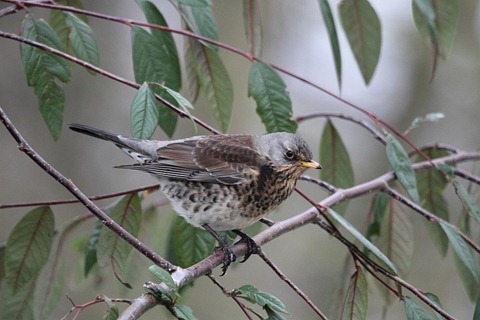We are blessed with a splendid array of woodland birds in our garden, largely because our garden backs onto a broad-leafed, silver birches being prominent with the occasional beech and oak. Though we are very keen to feed and observe “our” birds – we get very possessive of them – we have to be careful doing so because we are plagued by three much less welcome visitors: Grey Squirrels (Sciurus carolinensis), Magpies (Pica pica) and Woodpigeons (Columba palumbus). Our bird feeders need either to be squirrel-proof or be defended by a squirrel baffle. We’ve been mostly successful but, regrettably, at least one of the Magpies has worked out a way to raid our sunflower seed feeder.
Our welcome “residents” include about six Blackbirds (Turdus merula), members of the thrush family, who’ve proved difficult to feed without attracting the unwelcome guests. Put out a tray with seed on it and it quickly gets vacuumed up by a combined assault force of Grey Squirrels, Magpies and Woodpigeons. One blackbird, like the Magpie, has managed to crack the sunflower seed feeder but, in general, its kin have had to content themselves with scraps dropped onto the ground by the smaller birds. In the recent snows, however, we weakened and tried another blackbird-friendly approach: a modestly sized bird table. We were hoping that the larger Magpies and Pigeons would be unable to negotiate the bird table’s roof and be unable to land on it. That may have been a contributory factor but I think our choice of feed was more crucial; we put out just dried fruit and suet which the Magpies and Pigeons seem to shun. Result!
In our harsher winter weather, we’ve become used to seeing Redwings (Turdus iliacus), a winter migrant species of thrush, dining on the Cotoneaster berries overhanging our garden. Our resident Blackbirds have been quick to defend this food source and chase the noticeably smaller Redwings away. [See Berry Defensive.] This year, though we were delighted to be visited by another member of the thrush family, a Fieldfare (Turdus pilaris). [First Time Visitor.] Though I managed to snag a shot of it, a fence and its post were involved and I was keen for a better chance.
A couple of years ago, I remembered seeing Martin Hughes-Games, on a BBC Winterwatch programme, mention Fieldfares being fond of fallen apples, so I pinched Carol’s last Cox’s Orange Pippin, quartered it and put it out on the ground as Fieldfare bait. My Carol’s apple lay there untouched for five days. “So much for Fieldfares liking fallen apples”, I mused.
Things changed this morning, however, when we awoke and peered out of the window to be greeted by the sight of a Fieldfare very calmly breakfasting in the snow on Carol’s 5-day old apple pieces. Our guest had clearly been sitting there a little while because some of the previous contents of its gut had already been deposited on the ground where it sat. Well, snow makes that sort of thing fairly obvious. We watched. It continued sitting there, peering about watchfully, every now and then pecking at the apple.
Our resident Blackbirds arrived for their breakfast of dried fruit and suet. The Fieldfare stopped sitting calmly, became very animated and began chasing away any Blackbird within reach. I didn’t seem interested in the dried fruit and suet but it flew at the bird table and dislodged any Blackbird there. If a Blackbird chose to sit in the Cotoneaster bush, the Fieldfare flew up and chased it out. If a Blackbird simply landed on our patio, the Fieldfare hopped hurriedly after it puffing itself up and flaring its wings and tail feathers. This was a single-mindedly determined Fieldfare. The Blackbirds were outnumbered 1 : 6 – they’d met their match. 😀
My book has Fieldfares being about the same length as Blackbirds but to my eye it looks a tad bigger. Certainly, Fieldfares seem to be slightly more heavily built. I refreshed my Fieldfare bait with yet another of Carol’s apples, opened an upstairs window, dressed in coat and gloves against the freezing air and sat in wait hoping my quarry would follow a Blackbird or two into the Cotoneaster bush and sit in a more advantageous position. As I hope you can see, it eventually did just that.


Leave a Reply